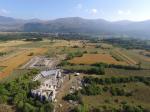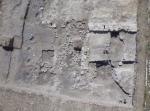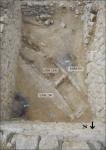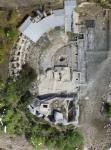Summary (English)
FORUM AREA
Here, trenches were opened along the east side of the temple and in the north-western area of the forum.
The excavation along the podium was positioned in correspondence with an irregularity in the coursing of the opus caementicium, still clearly visible in the restorations undertaken in the 1990s, which consolidate the masonry that was crumbling due to the post-antique robbing that took place throughout the city. The trench exposed impressions of the podium’s facing blocks and several cuts relating to the restoration and the robbing were documented.
In this area, 2015 trench was extended. A very large room (a) was partially excavated. Two adjacent walls were uncovered, only preserved at low level, which were on the same alignment as other forum structures. Wall 1 was built in opus reticulatum with the use of reused materials and repairs. Wall 2 was built in opus incertum and traces of red wall plaster were preserved on its interior face.There were two large patches of floor preserved in the room, seen in section during last year’s excavations. These were beaten surfaces, the latest of which had a plaster make up with some pottery inclusions, compacted on top of the earlier surface. The latter, presented clear traces of burning, clarifying the reason for the construction of a new floor. Several holes in this surface showed that this first floor had been laid directly on a layer of natural gravel. A preliminary study of the finds suggest a 4th-5th century date for the structure’s abandonment.
To the east there was a third room (3), also aligned east-west, in a very bad state of preservation. All the structures were heavily cut by middens/robber trenches and ploughing.
In the eastern part of the trench, the removal of the agricultural soil revealed a series of quadrangular pits of more or less uniform size. The pits contained ashy soil and abundant pottery fragments. Further excavation is necessary for a better understanding of the occupation phases in this area.Levels relating to the forum’s floor surface were also exposed. The floor was originally constituted by the natural gravel surface, which was then levelled using silty materials. The paving made of local stone differs from the few limestone paving slabs situated in front of the north wall of a small building immediately north of the temenos. However, these were reused slabs.
THEATRE AREA
Excavation in the southern sector of the theatre continued to uncover a complex stratigraphy. The strip of terrain between the fortalice and the theatre had been the object of repeated interventions between the post antique period and recent times: robbing of the blocks from the seating and paving slabs from the orchestra floor, construction of the fortalice and subsequently rooms in the workers quarter, excavation, and the restoration of the fortalice. All of this makes it difficult to interpret the relationships between the various structures, in particular the post-antique ones that for a certain period shared the use of the hillside route leading to the church of San Paolo. A short surviving section of the church’s southern perimeter was identified, built in large limestone chips. Continuation of the investigation in room δ reached the level of the theatre’s annular sewer channel. Its cover slabs had been removed and the floor surface of one of the rooms forming the Renaissance workers quarter was constructed over it.The internal walls of the opus reticulatum parapets were all that were visible of the channel dug into the silty soil.
- Luisa Migliorati - Sapienza Università Roma
Director
Team
- Antonella Pansini - –Sapienza Università di Roma
- Claudia Micari
- Dario Canino
- Federica Pirré
- Giulio Casazza
- Ilaria Trivelloni - –Sapienza Università di Roma
- Leonardo Radicioni
- Luca Volpi
- Tiziana Sgrulloni





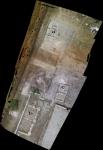
![Download [PDF]](/excavation/skins/fasti/images/results/download_sml.png)
